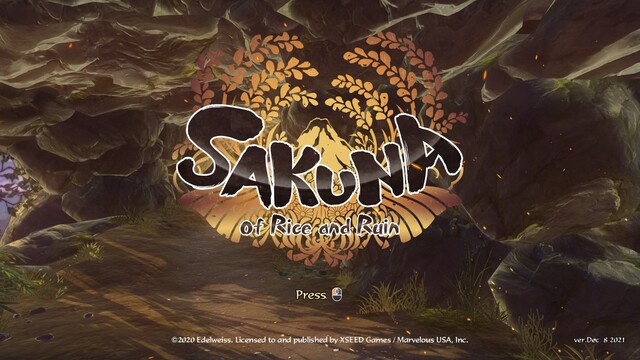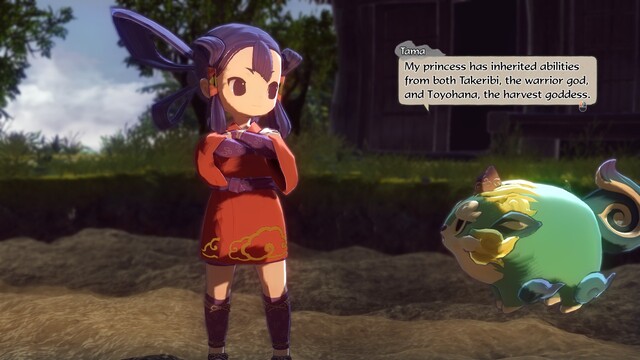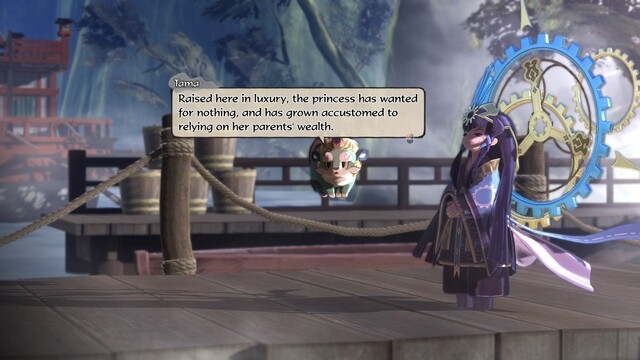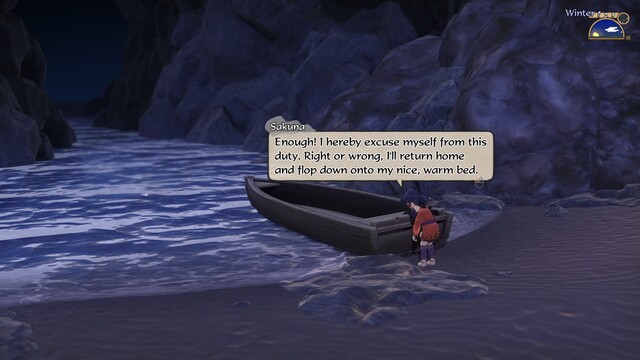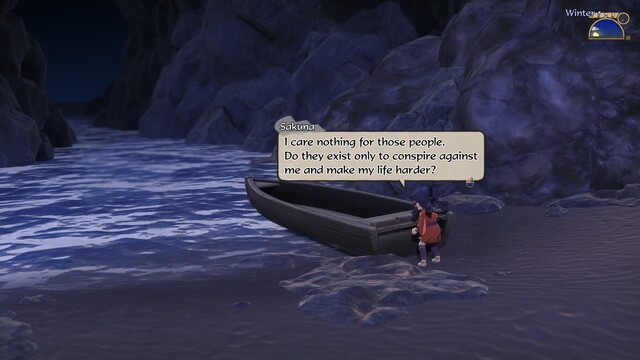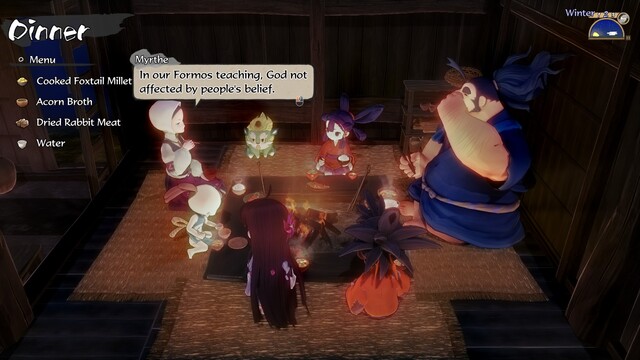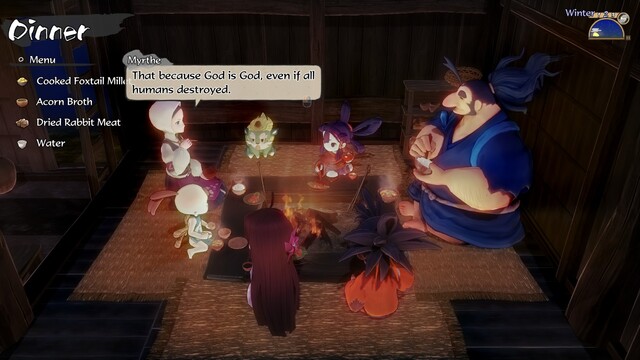Sakuna of Rice and Ruin is a hybrid side-scroller and farming game. The titular character Princess Sakuna is a goddess who lives in the capital of the Lofty Realm, the realm of gods. That is until a group of hungry humans crossed the Heavenly Bridge into the capital and ruined Sakuna’s tribute of rice to the Pre-eminent Goddess Kamuhitsuki.
By in-game mythological order and morality, gods and goddesses protect and can not redirect blame onto humans. For the incident, Sakuna along with the humans are banished from the capital to the Isle of Demons. They are allowed to return only after the island has been conquered for Kamuhitsuki.
The mysterious Isle of Demons is also the homeland of Sakuna’s parents. Upon arrival, Sakuna and her (undesired) following take up residence in the former family home at a mountain pass. In order to survive and because humans can not safely forage amongst demons, Sakuna hunts for meat and farms rice.
More on the Characters
By in-game mythos, gods and godesses dwell in the Lofty Realm. Although they are divine entities, they are not above human nature and prone to vices. Besides their powers manifest by their divinity, they are much like humans in shape and form; they live mortal lives and need to eat.
Sakuna
You can’t change the rank you’re born into. Bwahaha!
Sakuna, to her friend Kokorowa
Sakuna is conceited and petulant. She is the daughter of a warrior god and a harvest goddess. Her familiar Tama describes her to have relied on her parents wealth and lived comfortably in the capital.
I found this character astoundingly selfish and short-sighted. In the winter of her first year of exile, she throws a tantrum about her living conditions and tries to row a boat back to the capital herself, attempting to abandon humans— three of which children— to an island of demons.
Can one enjoy making a dislikable character toil in manual labor?
Sakuna falls under both the brat and the “plucky girl” archetype making her an unusual heroine. This type of character is uncommon if not rare for a lead character for practical reasons as she can be annoying. Because I got tired of listening to her complaints as she tills the soil and plants seedlings, I changed the game’s voice language to Japanese that way I have less of an idea of what she’s saying.
Sakuna shares some similarities with May from Guilty Gear. Both are adults of childlike stature and youthful demeanor. Though I think May is more tolerable.
Tama
Tama is Sakuna’s familiar who takes the form of a fluffy green-colored carnivoran. (He has features reminiscent of four-legged mammals of the taxonomical order Carnivora but is not of any real species) In the past, he had similarly served Sakuna’s parents Lord Takeribi and Lady Toyohana.
Kokorowa
Kokorowa is a friend of Sakuna who lives in the capital of the Lofty Realm. She is a goddess of invention. Her colors are blue and purple; an arrangement of floating gears float behind her back.
She engineers mechanical soldiers to provide security in the capital. However, when paying tribute to Lady Kamuhitsuki, her accomplishments are overshadowed by Sakuna’s (parents’) wealth.
The humans who dragged her into the mess
Beyond the context of the story, the human characters function as NPCs who perform tasks around the settlement. They also facilitate special story-related events.
Tauemon
Tauemon is a former samurai— a deserter turned bandit turned ex-bandit who rescued a woman and three children from slavery. Tauemon is knowledgeable about fieldwork but is clumsy and error-prone.
Tauemon is a guide for the farming portion of the game. If the player does not complete farming tasks before a deadline, Tauemon completes instead. The result is however of a lower quality.
Myrthe
Myrthe is a blue-eyed woman from the fictional region of Ventania (analogous to the Netherlands) who had traveled for missionary work. The religion she followed is called Formos which is implied to have a single omniscient god. Myrthe provides the context for explaining Japanese polytheism.
Myrthe is the interface for culinary tasks such as cooking, food storage, and food processing.
Kinta
Kinta is a snooty boy who will quarrel with Sakuna. Before entering the Lofty Realm, he had lost his parents to war and had been taken in by a corrupt monastery from which he fled.
After settling on the Isle of Demons, he becomes a blacksmith and forges weapons for Sakuna.
Yui
Yui (meaning ‘to tie’) is a girl who is secretive about much of what she does and is often assumed by others to be shy. After Sakuna builds a loom for her, she tailors equipment.
Kaimaru
Kaimaru is a young child who can barely form words.
When Kaimaru is assigned to forage for resources in a new area, he befriends and brings home animals such as dogs, cats, and ducks which serve various functions around the farm.
Game Design
Farming
Farming levels up Sakuna. Good dinners confer stat bonuses and buffs.
The game features a detailed representation of rice farming. The farming section of the game includes:
- tiling soil
- planting seedlings
- applying fertilizer
- harvesting
- laying rice out to dry
- threshing
- hulling rice
… with the following variables factored:
- seasons
- weather and temperature
- root, kernel or leaf fertilizer
- water level
- pests or weeds
- diseases
For each section, the player has agency in how much effort to invest for better or worse results. In the first year, I found myself agreeing to the prompts when I could instead postpone harvest until autumn or wait extra days for rice to dry. While there are plenty of rooms for mistakes on the first try, the player can still rely on hunting meat for sustenance. However, as Sakuna is a goddess of harvest, good farming grants her new abilities and strength for combat.
Combat and Platforming
Here is an overview of game mechanics:
- the game camera is completely autonomous
- no health potions or analogous restoratives
- an effective time limit as to how long Sakuna can spend outside of home
The effective time limit is roughly one in-game day. Dinners generally grant the in-game buffs Swift Recovery and/or Natural Healing which allow Sakuna to recover health points after combat. At the end of the day, Sakuna becomes hungry and the buffs disappear. Additionally, as the enemies are demons, they grow stronger at night and will outlevel the player (unless the stage is a replay). The culmination of these mechanics forces a progression-matched player to retreat home for dinner and rest.
An overview of the combat mechanics:
- (ground) dash
- a grappling hook (Divine Raiment)
- contextual deflect (parry)
- no double jump1
- no enemy step
- no air dodge
- enemies take damage on collision with each other (“crashing”)
- enemies are invulnerable after knockdown
- Divine Raiment skills can be used on enemies upon parry, upon launch, upor on knockdown
Sakuna wears a shawl inherited from her mother called the Divine Raiment. The Divine Raiment effectively is a grappling hook with a few unique abilities; it is similar to Nero’s Devil Bringer (un-upgraded) from Devil May Cry 4 in that it can pull Sakuna to enemies or enemies to Sakuna. While Sakuna can launch an enemy to the air, she has few utilities to mitigate damage while airborne.
Some enemies in the game fly such as Demon Fish or Demon Sparrows. The game generally spawns groups of enemies both flying and groundbound. For many encounters, I found the middle-mouse ability Tidal Wave far more useful than most other abilities solely for the large sharkfin-shaped projectile (“wave”) it launches. This projectile has a height of either 1/3 to 1/5 of the screen (depending on camera) that staggers enemies and disarms projectiles it makes contact with.
A low-carb-high-protein diet isn’t good enough for these people
For the first two years of the game, I was a bad rice farmer. When I had stepped into the rice field and heard bare feet slapping on wet soil, I assumed I didn’t need to irrigate. I had forgotten that rice fields are flooded with water and realized I could adjust water levels of the field.
By the second year of the game, I had only a yield of only 20 units of rice which barely lasted through the winter. So I had mostly fed the settlement dried meat. I didn’t think there was any issue subsisting on that diet until having a Rice Level of 10 and an Exploration Level of 41+. At that point, getting caught at a bad moment in a group of enemies was a game over (stage reset). She needed a break after each fight, and eventually was unable complete the stage before sunset.
Lesson learned: be good at rice farming and eat good dinners.
My Commentary on Sakuna’s Defensive Options
In combo-based action games, there are multiple control schemes to deflect incoming damage either as a block or parry. One is a contextual where the parry or block action shares the same bind as movement; depending on the context, the player character either moves or deflects an attack. To illustrate, for a two-dimensional game, the key ‘D’ deflects attack coming from the right given the right moment but results in the player character moving toward the attack if the timing is wrong. This is how parrying (or blocking) is performed in Sakuna of Rice and Ruin, Metal Gear Rising, and Bayonetta. The alternative scheme is a dedicated button which is present in Devil May Cry 3 and its later iterations.
I prefer a dedicated button. Even though I can see an attack coming, I don’t always input at the right moment. If a demon from Devil May Cry swings its scythe at Dante, I don’t mind taking chip damage from an imperfect block especially if I’m not playing for perfection. In the case of Sakuna of Rice and Ruin, the granularity for taking chip damage doesn’t exist.
Unexpected Equipment Mechanics
The game is playable with unupgraded equipment.
Demons drop a currency called Amber. Amber is used to augment fertilizer and upgrade equipment. However, using Amber to upgrade equipment was only given a passing mention in a different context.
For most of the game, the only use of Amber I had known was to be dumped in the fertilizer pit to augment the rice field. I was of the assumption there was an undiscovered tool or interactable to upgrade equipment. So I overlooked a menu until very late in the game. I also didn’t realize how to use Spirit Boughs. (They are modular item modifiers that can be inserted and removed from a free slot in a piece of equipment.)
The game is likely balanced such that it is possible to complete the game with unupgraded equipment. Canonically, Sakuna acquires the weapons needed to defeat the final boss.
Overall
Sakuna of Rice and Ruin as a whole is more charming even as the parts (platforming, combat mechanics, RPG elements) are mediocre on their own. The characters are both eloquent and concise as they express their emotions and motivations; the characters that are of humbler origins remain in-character.
Because of Sakuna’s initial characterization, she is a dislikeable lead character. Nonetheless, the game’s narrative has many hooks to guide the player’s curiosity especially towards that of the game’s world and mythos.
No disruptive technical issues (e.g bugs, crashes) encountered as of 57 hours of playtime.
Nuisances
retrying boss fights can be inconvenient as some introduction sequences are unskippable
the exploration objective for the Den of Fangs is based on random chance; it became the last objective I needed to 100% explore the island 2
undisclosed specific abilities required to flip a turtle (exploration objective) 3
inefficient interface for changing the dinner menu; items are sorted low-tier first, no options to filter by attribute; by the late game, the player has to scroll a lot to find certain items
“wet plastic doll” graphics;
The 3d models have an anime art style but do not override environmental lighting. In certain scenes of the game, especially depicting direct sunlight, the models start to look like plastic dolls instead.
The words ‘god’ and ‘kami’ (musing)
During dinner, the group will ask Myrthe about her homeland or her travels. The discussion steers to cultural differences and religious differences. The religion Mytthe follows is analogous to Christianity in that there is a single god that doesn’t have the constraints that Sakuna has. (Sakuna, like humans, gets hungry, has to eat, and isn’t invincible.) Myrthe interprets that Sakuna is an angel to which Sakuna takes offense.
This scene made me think about the differences in language. In Japanese, the word “kami” arguably translates to “god” or “spirit” depending. Whereas “deity” stems from the Latin word deus which is a cognate of Zeus, a chief among gods in Greek mythology. While Sakuna is a goddess, she isn’t analogous to the major entities such as Zeus or Goden (variant of Odin).
the skill Swallow Slice bound to Up + Middle Mouse provides vertical movement instead↩︎
Den of Fangs :: Sakuna: Of Rice and Ruin General Discussions, https://steamcommunity.com/app/1356670/discussions/0/2981907749285174807/↩︎
Flip a hiding turtle over :: Sakuna: Of Rice and Ruin General Discussions https://steamcommunity.com/app/1356670/discussions/0/2981907749297454738/↩︎
